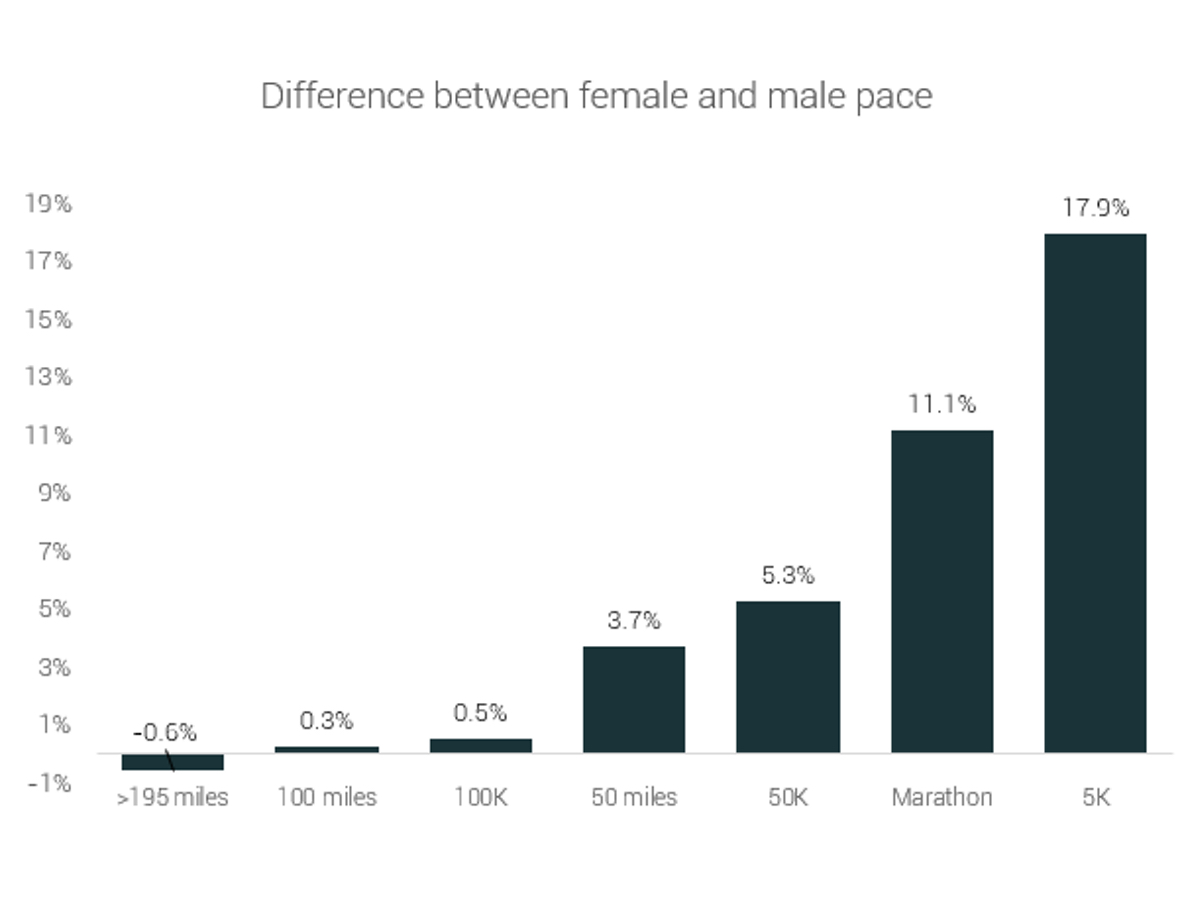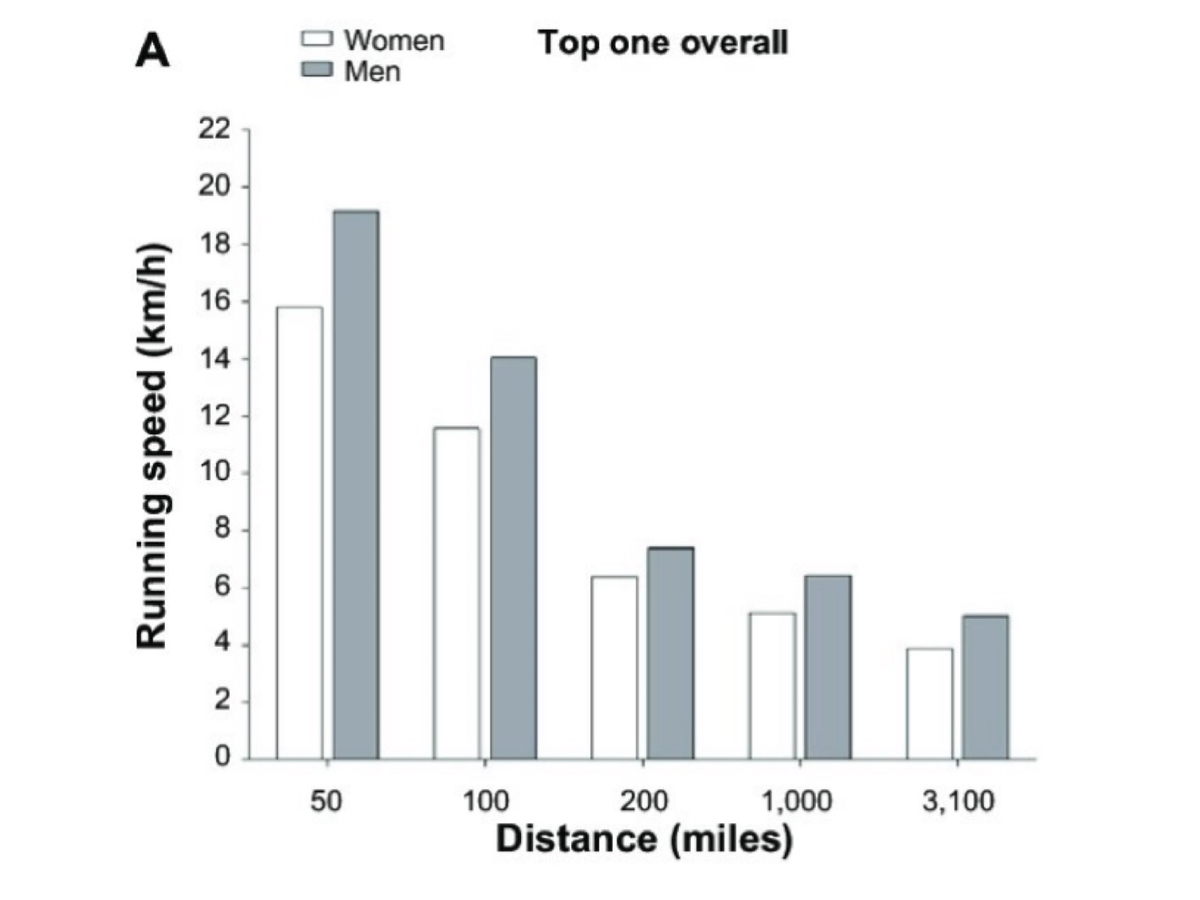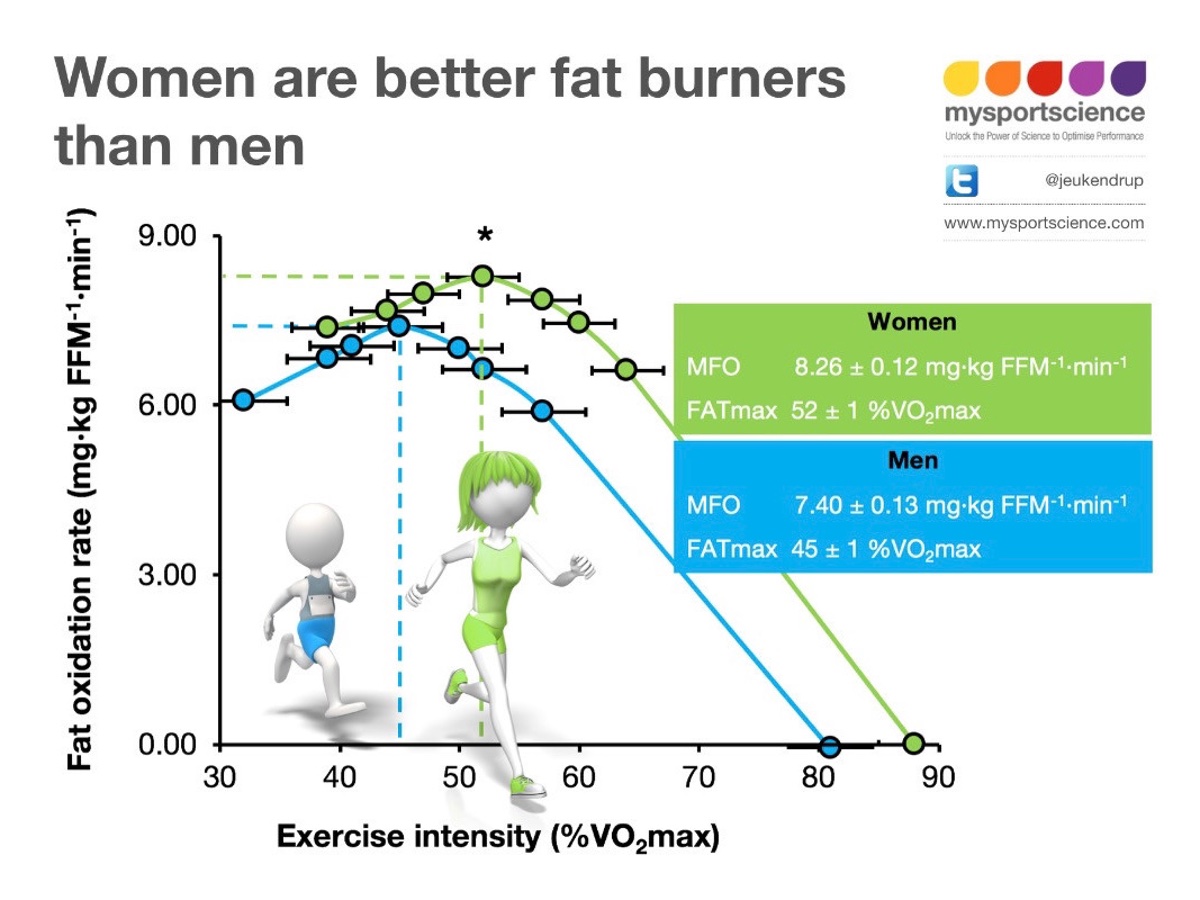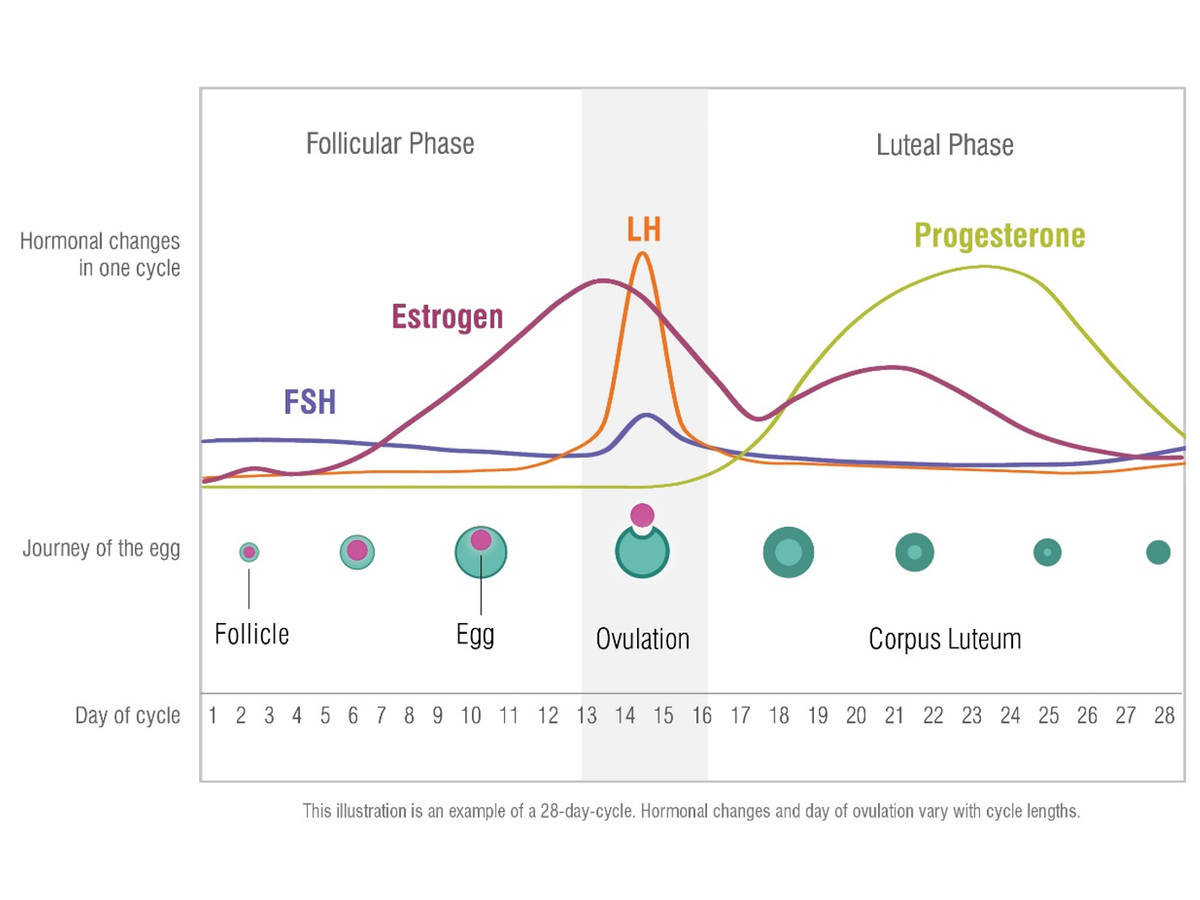Females get stronger as distances lengthen, or so says ultrarunning urban legend.
The science-driven side of me wonders if there is scientific truth to the anecdotes which have created this mythology. Turns out, others wonder, too. A monumental review article called “Do Sex Differences in Physiology Confer a Female Advantage in Ultra-Endurance Sport?” was published in January of 2021 in the journal Sports Medicine and it reviews a whopping 217 research papers on this topic (1)! In this article, we examine this gigantic paper.
The Nitty Gritty: Issues in Sex-Based Ultra-Endurance Sports Research
Before diving in, let’s cover two issues which affect the data we have on sex-based differences in ultra-endurance sports research and our conversation about them.
In the laboratory, endurance-sports research is predominately done on male volunteers, more specifically healthy, college-aged males. Female volunteers pose a complication, both real and perceived, which stems from hormonal fluctuations throughout their menstrual cycle. For research to be done well, time and resources must be used to account for this important variable. So, more often than not, research uses those more convenient males. Additionally, in a field setting, like in studying runners during an ultramarathon, there are far fewer female participants from which to recruit. A lack of female participants in research means more research is needed before we can reach firm conclusions on sex-based differences in ultra-endurance sports.
Also, we take a moment to mention the definitional differences between the words “sex” and “gender.” In this article, we follow the recommendations from the National Institutes of Health and use “sex” to refer to the biological, genetic, cellular, and molecular differences (for example, male and female) while “gender” will refer to the social constructs formed by society (for example, men, women, and nonbinary).
Ultra-Fast: Female Ultramarathon Performance
In 2020, researchers analyzed over 5 million results from more than 15,000 running events between 1996 and 2018, and calculated the average pace and finishing times of all finishers. They found that as distances grew longer, the performance divide closed between female and male runners. In fact, they found that females were faster than males at distances over 195 miles (8). Another recent study looked at the 10 fastest females and fastest males at distances from 50 miles to 3,100 miles and found different results, that males outperform females every single time, by roughly 10 to 19% (2).
So, the current data show that males outperform females relatively uniformly in front-of-pack performance, but in full-pack performance, males outperform females at steadily decreasing amounts as distance grows.

The difference in full-pack running speed between females and males in races of varying lengths from 5k to over 195 miles. Image: Runrepeat.com/state-of-ultra-running (8)

The difference in front-of-pack running speed between females and males in ultramarathons. Image: Zingg MA, Knechtle B, Rosemann T, Rüst CA. Performance differences between sexes in 50-mile to 3,100-mile ultramarathons. Open Access Journal of Sports Medicine. 2015;6:7-21 (2).
What Physiological Factors Determine Success in Ultramarathons?
When it comes to the marathon, we know that finishing times are greatly influenced by VO2max, lactate threshold, and running economy. However, these factors have been shown to be less influential in ultra-endurance performance (3). What this means is that success in ultramarathons must be determined by the interplay of other physiological characteristics. The likely culprits are:
- fatigue resistance (how long your legs and lungs can keep going),
- muscle morphology (muscle structure and fiber type),
- substrate utilization (how well you utilize carbohydrates, fats, and proteins for fuel),
- endocrine function (how hormones impact the body’s tissues), and
- mitigating gastrointestinal distress (it’s best to keep the fuel in) (1).
How are these affected by sex, if at all?
Ultra-Fatigued: How Muscle Type and Fatigue Vary in Females and Males
We are all familiar with the sensations of being mentally and physically tired in the final third of an ultra. This fatigue can be perceived fatigue, but it’s also very real physiologically. This is called neuromuscular fatigue and is where you experience a decline in ability to voluntarily activate (contract) your muscles. In both the lab and in the field at races like UTMB, females generally outperform males when it comes to neuromuscular fatigue (1, 4). How does this work? It seems there are three main culprits for resistance to muscular fatigue: muscle-fiber type, muscle mass, and general neuromuscular control.
You’ve likely heard of the two main muscle-fiber types, slow-twitch and fast-twitch, or type I and type II, respectively. Just like the names suggest, these muscle fibers are better at doing certain levels of intensity. Type-I/slow-twitch fibers are best at long aerobic work due to their high mitochondrial content. Because of this, they are considered to be incredibly fatigue resistant. Type-II/fast-twitch fibers are much better at contracting rapidly and generating lots of power. However, they also fatigue much more quickly. While we all have our own individual makeup of both of these fiber types inherently and due to our training, females generally have a higher percentage of type-I/slow-twitch fibers compared to males (44% versus 36%).
The next piece of the puzzle is that males have greater muscle mass than their female counterparts, because each individual muscle fiber is larger in diameter. This is important because larger-diameter muscle fibers receive less blood flow during submaximal contracts like in an endurance event.
These two factors combined create a much greater demand on the cardiorespiratory and central nervous systems, leading to neuromuscular fatigue for male ultrarunners sooner as compared to female ultrarunners.

Slow twitch/type-I and fast-twitch/type-II muscle fibers each have their own strengths and weaknesses. Image: Slideplayer.com/slide/13180203/
How and What You Eat: Substrate Utilization and the Sexes
When it comes to training for and racing ultra-endurance events, we know that carbohydrates and fats provide most of the energy our body requires. As we discussed in our article on substrate utilization, as distances increase and intensity subsequently decreases, we rely more on fat to provide energy to our working muscles. This is ideal because we have rather abundant fat stores naturally on our body and a much more limited supply of glycogen via carbohydrate stores in our muscles and liver. Utilizing this fat in turn spares our glycogen stores and hopefully staves off an energy bonk. Research currently suggests that compared to males, endurance-trained females utilize more fat even at rest.
Additionally, females utilize more fat as a percentage of their daily total energy expenditure and reach maximal fat oxidation at higher levels of intensity than males. One of the interesting reasons for this is that females have a more of a specific protein (CD36) that makes the transportation and utilization of free fatty acid metabolism more efficient. The other factor that is believed to make females better at fat oxidation is estrogen–oh yes, hormones–as it enhances fat oxidation while downregulating glucose utilization.

Females are slightly better at oxidizing fat than males, with their peak fat oxidation about 10% higher and taking place at a higher exercise intensity. This makes females suited to prolonged endurance exercise where fat is the primary fuel. Image: Mysportscience.com/post/2017/10/10/women-are-better-fat-burners-than-men
Helpful Hormones: Sex Hormones and Ultra-Endurance Performance
Our sex hormones, estrogen, progesterone, and testosterone, play a role in physiology beyond reproduction. Historically, estrogen and progesterone are thought of as female hormones and testosterone as a male hormone. However, all three are present in both sexes and each play different roles and are present at different concentrations. In this section, we discuss how estrogen and progesterone affect female performance and how testosterone affects male performance.
Menstruating females experience the natural rise and fall of both estrogen and progesterone over the course of their menstrual cycle. The menstrual cycle is broken up into three distinct phases: the early follicular phase which is characterized by both low estrogen and progesterone, the ovulatory phase which is characterized by high estrogen and low progesterone, and the luteal phase which is characterized by high estrogen and high progesterone.
Estrogen has lots of positive impacts on female athletic performance, including sparing glycogen while allowing us to utilize more fat as fuel, protecting against muscle damage, reducing inflammation (speeding recovery), and increasing voluntary activation of our neural pathways. This generally equates to female endurance athletes feeling good when estrogen is high. Progesterone dampens the effects of estrogen, which we see in the luteal phase and which means you might not feel the same estrogen boost that you experience during the follicular phase.
One hiccup for estrogen is that it can affect the elastic properties of muscles and connective tissues. This topic has predominately been looked at from a correlation (not necessarily causation) standpoint, but has led to some concern that female athletes are potentially at higher risk for connective-tissue injuries compared to males. Hopefully this will be an area for further research.
If you’d like to learn more, we previously talked in more depth about how hormones and the menstrual cycle affect female sports performance.

The female menstrual cycle lasts 21 to 35 days, and is generally presented as seen here, in an idealized 28-day cycle with a rise and fall of estrogen during the follicular phase and the rise of progesterone during the luteal phase. Follicle stimulating hormone (FSH) is responsible for the growth of the egg in the ovary and luteinizing hormone (LH) is responsible for the release of the egg from the ovary. Image: Zrtlab.com/blog/archive/how-your-hormones-affect-athletic-performance/
Testosterone is considered one of the leading physiological factors in the gap between male and female athletic performance, particularly in sprinting and power sports. This is because testosterone, starting at puberty in males, is responsible for the development of greater muscle mass, a decrease in body fat, higher hemoglobin concentrations (which are important for oxygen transport), and an increased ability to synthesize protein (which aids in recovery).
One possible downside of higher testosterone in males is that it is associated with increased impulsiveness and risk-taking behavior. When evaluating pacing over the course of a 100-kilometer race, researchers found that females exhibited slower relative starting speeds but higher relative finishing speeds than males (7). These findings hold true in more comprehensive marathon studies where the mean change in pace through a race for males was 15.6% versus 11.7% for females (1). Though some of this pace change could be accounted for by fatiguability of muscles (wherein females are more fatigue resistant), researchers believe it might also be a product of decision making, over-confidence, and risk perception, all of which are influenced by the presence of testosterone (5). More research is needed to help determine testosterone’s overall impact on male ultra-endurance performance.
Stomach Woes: Gastrointestinal Stress Varies by Sex
When people drop out of ultras, the top-two reasons are undertraining and gastrointestinal (GI) distress (6). GI distress comes in various flavors and includes nausea, vomiting, cramping, reflux, bloating, and diarrhea. As discussed in our article on eating during ultras, GI distress is not generally caused by any one thing, but instead, the perfect storm of several things going wrong. Females report higher rates of GI distress, and the question is, why (1)?
This area is not well understood yet, but there are some really interesting factors that might be in play. On average, females have physically smaller stomachs than their male counterparts by approximately 10%, which might mean that females are less capable of accommodating volumes of food. Females also have slower gastric-emptying rates (the rate at which substances leave the stomach after ingestion) than males, which could potentially lead to bloating and other downstream problems. What this all means is that GI distress likely has a sex component, and this may impede female ultra-endurance performance.
Wrapping it Up: We Have a Lot to Learn!
As we said at this article’s outset, it’s hard to properly draw big conclusions from research on female physiology in ultra-endurance sports just yet. It’s not fair to say that our knowledge is completely lacking, but it’s important to acknowledge that we still have a long way to go in order to make meaningful comparisons across the sexes.
Additionally, it’s important to note that although we evaluated many physiological traits, there are likely additional factors that influence performance, including and perhaps especially psychology.
What we can deduce now is that there are several specific physiological factors that may allow females to excel while others that also impede them in finding success in ultra-endurance sports. The factors that stack the deck in the favor of females are greater fatigue resistance (due to muscle-fiber type and size) and a greater efficiency in utilizing fat as fuel. The factors that are possibly hurdles for females in ultra-endurance performance are higher rates of GI distress and the possible impacts of hormonal fluctuations on metabolism and soft tissues. It would be easy to think females are at a draw, but truthfully I think we are just getting started.
Call for Comments
Females, leave a comment to share your anecdotal stories about ultramarathon performance and what aspects of your physiology you think help and hinder your running.
References
- Tiller, N. B., Elliott-Sale, K. J., Knechtle, B., Wilson, P. B., Roberts, J. D., & Millet, G. Y. (2021). Do sex differences in physiology confer a female advantage in ultra-endurance sport?Sports Medicine. doi:10.1007/s40279-020-01417-2
- Zingg MA, Knechtle B, Rosemann T, Rüst CA. Performance differences between sexes in 50-mile to 3,100-mile ultramarathons. Open Access Journal of Sports Medicine. 2015;6:7-21.
- Davies, C. T. M., and M. W. Thompson. 1979. “Aerobic Performance of Female Marathon and Male Ultramarathon Athletes.” European Journal of Applied Physiology and Occupational Physiology 41 (4): 233–245.
- TEMESI, J., ARNAL, P. J., RUPP, T., FÉASSON, L., CARTIER, R., GERGELÉ, L., . . . MILLET, G. Y. (2015). Are females more resistant to extreme neuromuscular fatigue?Medicine & Science in Sports & Exercise, 47(7), 1372-1382. doi:10.1249/mss.0000000000000540
- Hubble, Calvin, and Jinger Zhao. 2016. “Gender Differences in Marathon Pacing and Performance Prediction.” Journal of Sports Analytics 2 (1): 19–36.
- Hoffman, Martin D., and Kevin Fogard. 2011. “Factors Related to Successful Completion of a 161-km Ultramarathon.” International Journal of Sports Physiology and Performance 6 (1): 25–37.
- Renfree A, Crivoi do Carmo E, Martin L. The influence of performance level, age and gender on pacing strategy during a 100-km ultramarathon. European Journal of Sport Science. Taylor and Francis Ltd.; 2016;16:409–15.
- Ronto P, Nikolova V. https://runrepeat.com/state-of-ultra-running




